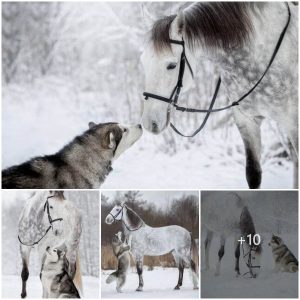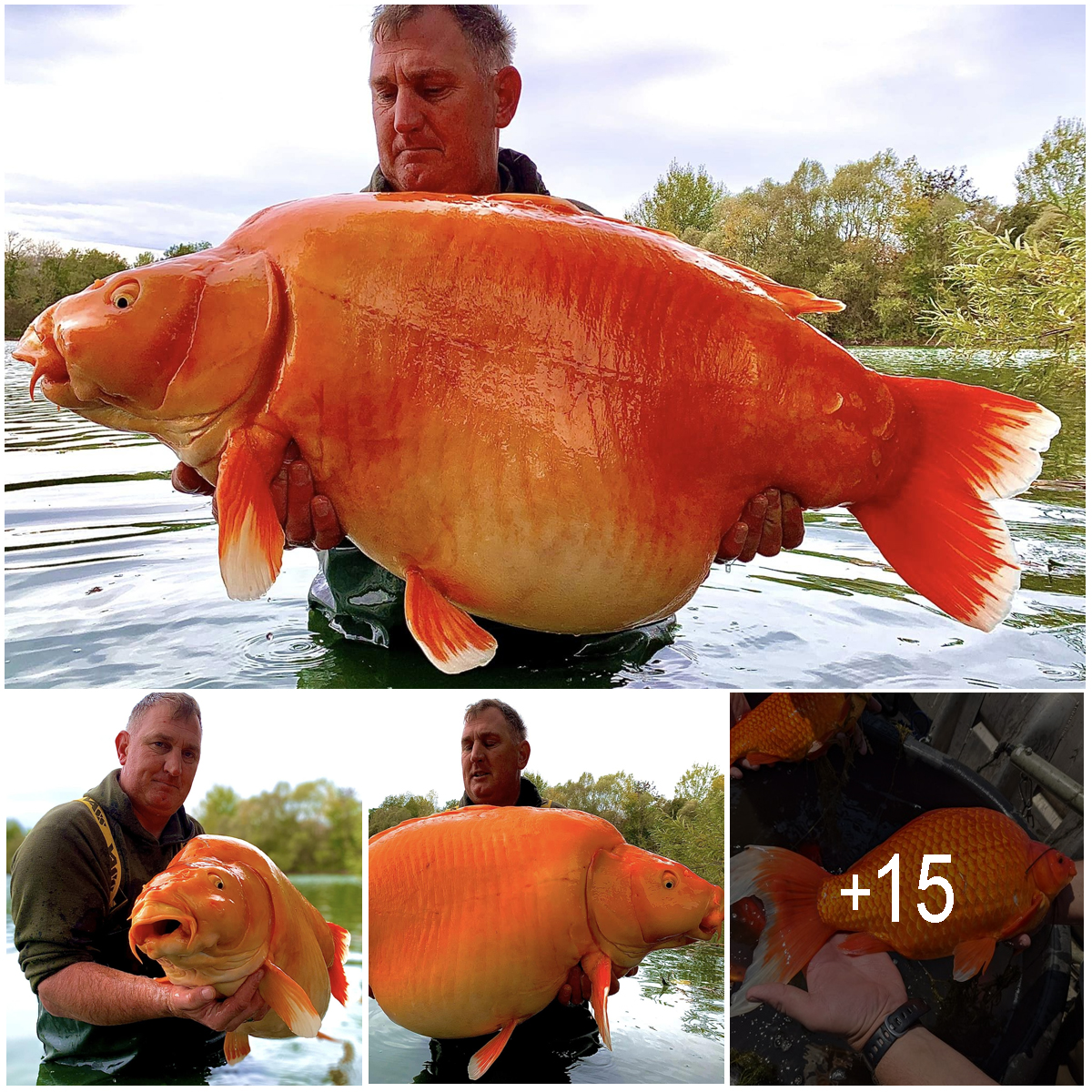
While all horses are beautiful, some of them have extravagant coat colors with an additional wow factor. These unique horse colors have the power to transform an ordinary animal into a magical fairytale creature that turns heads wherever it goes.
Generally, the most common horse colors are bay, chestnut, gray, black, and dun. Pinto and spotted coats are also common in certain horse breeds but rare in others.
As you’re about to learn, nature can produce some truly unique horse colors you wouldn’t believe exist in real life. They are not only beautiful, but also have a fascinating genetic background that makes them stand out in the horse world.
Here are the fifteen most unique and rarest horse coat colors.
Brindle

Brindle is a type of chimera coat pattern. While it’s relatively common in dogs and cows, brindle is by far the rarest coat color in horses.
Brindle stripes can show up on any base color in the form of light or dark hairs. Because this pattern is a result of two embryos fusing, the hairs making up the stripes can be a different texture to other body hairs. Brindle markings are always vertical and usually don’t extend to the head and legs.

The most eye-catching brindle horses have a sharp contrast between the stripes and their base coat color. Examples are gray or golden brindles with striking black markings.
Just like other chimera patterns, brindle coats are not normally heritable. However, in late 2016, scientists have identified a heritable brindle gene (Brindle1 or BR1) in a family of American Quarter Horses.
Cremello
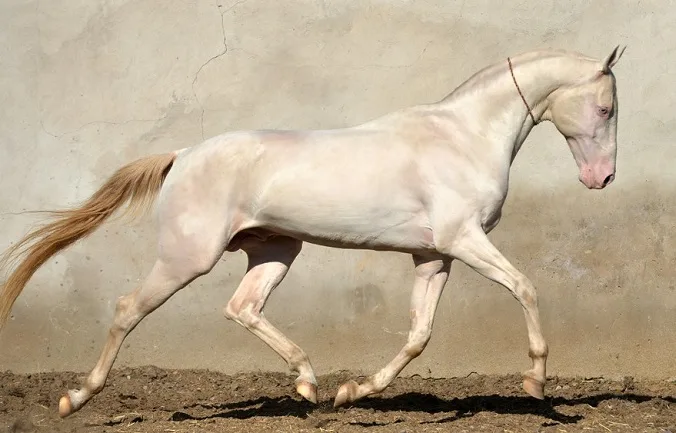
The cremello is a unique horse color that features cream hairs, blue eyes, and pink skin. Some people refer to cremello horses as white or albino, although their genetics differ from these.
A cremello horse has a chestnut base color and two dilution/cream genes that lighten all hairs to nearly white. This color is typical in the Akhal-Teke, Lusitano, and certain pony breeds.
Perlino horses are similar to cremellos, except their base color is bay. As a result, their manes and tails are darker than their bodies, often reddish or rust in color.
Chimera

The chimera is possibly the most eccentric horse color among all. It is created when a rare and bizarre DNA error causes two non-identical twins to fuse in the womb. The result is a horse with two sets of DNA that will show both coat colors at birth.
Chimera horses can display a combination of any two horse colors. Their pattern will depend on how the embryos fused prior to birth and follows no particular rule. Chimerism is extremely rare in horses and cannot be passed on to offspring.
Gold Champagne
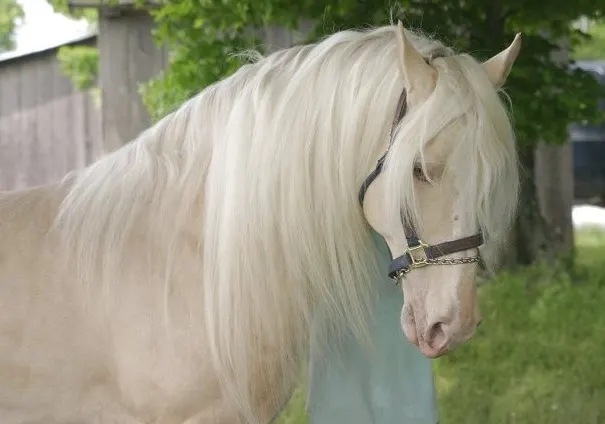
Champagne horses have a black base color that is modified by the rare champagne gene. These horses will have blue eyes at birth that change to hazel as they grow older. The champagne gene also causes pinkish skin with freckles and golden or brown hairs.
Gold champagne is a truly fabulous version of the classic champagne and often has a metallic shine. Gold champagne horses have a chestnut base color that is lightened by the champagne gene. They will also have lighter skin, hair, and eye color than a classic champagne horse.
Silver Buckskin
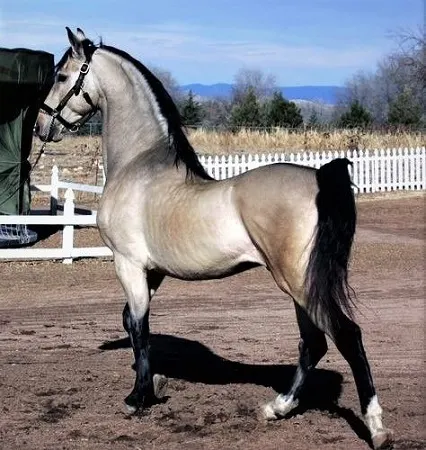
The silver buckskin is a rare horse color with dark points and a silver coat. This is the result of the rare silver gene that lightens dark hairs on the horse’s body, producing a silver coat.
While the term is used to describe a variety of horse colors, a true silver buckskin must carry the silver gene. This gene only affects black hair pigment and often causes a silver mane and tail. However, a silver buckskin retains its black points, with the silver gene only showing up on the body.
Metallic Sheen

While not strictly a horse color, a metallic sheen is displayed by certain horse breeds related to the Akhal-Teke. This rare trait puts a unique spin on the horse’s coat, making it shine like molten metal.
A metallic sheen was originally characteristic of the Akhal-Teke breed of Turkmenistan. These horses have been around for at least 3,000 years and are famous for their speed, intelligence, and endurance. Due to their shiny coat, Akhal-Tekes earned the nickname “Golden Horses.”
The cause of their unique metallic sheen lies in the Akhal-Teke’s hair structure. Unlike in other horses, the hairs of Akhal Tekes fold on top of each other in a specific scale pattern. The cuticle of each hair shaft is also particularly smooth and flat, contributing to the metallic glow.
The distinctive shine is most noticeable in dilution horse colors, such as the cremello, champagne, buckskin, and palomino.
Other than the Akhal-Teke, certain Russian horse breeds that trace their ancestry to this breed also feature a metallic sheen. These include the Don, Budyonny, and Karabakh horses.
Silver Dapple Pinto
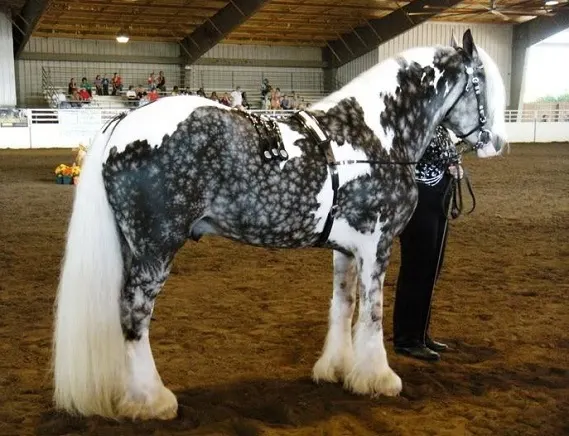
Silver dapple horses are already beautiful, but silver dapple pintos are even more special! This unique horse color combines the fabulous silver dapple coat with pinto coloration.
Silver dapple pintos are quite rare and most often occur in the Gypsy Vanner breed. The color was also noted among American Miniature Horses.
Horses with this coloration have a black base color that’s lightened by the silver gene. Moreover, the dapple gene is responsible for the white or grey spots we see in this eye-catching horse color.
Buckskin Pinto

Like silver dapple pintos, buckskin pintos boast a combination of their base coat color and pinto spotting pattern. Buckskin horses have one dilution gene that fades their original bay color into various shades of cream and gold. Meanwhile, their black points (mane, tail, and legs) remain intact.
Buckskin pintos are uncommon compared to other pinto colorations. They can show up in a variety of horse breeds, including the Gypsy Vanner, American Paint Horse, or Mustang breeds. Due to their rarity, buckskin pintos have a higher price tag in general than horses with more common coats.
Sabino
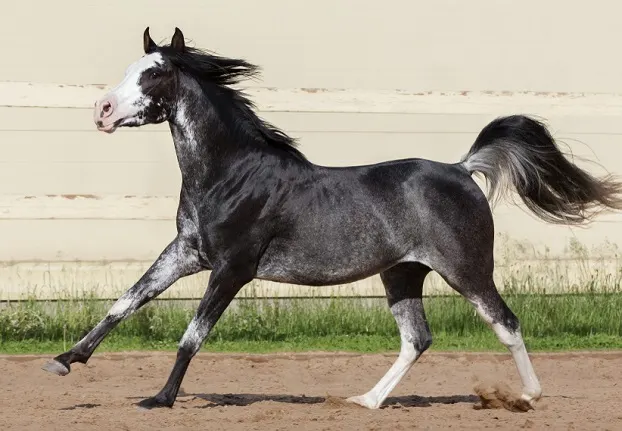
This unique spotting pattern can appear on any base color. A rare and eye-catching combination is a chocolate sabino that has a brown and white coat and bright red mane.
Red Rabicano

A red rabicano horse has a chestnut base color and sparse roaning typically limited to the underbelly, flanks, tail, legs, and head.
While true roans have white hairs mixed with colored hairs throughout the body, rabicanos only show this trait in part of the body. Rabicano horses also don’t have darker heads and legs compared to the rest of the body.
This rare horse color is the result of a genetic modifier that produces a mealy pattern on certain areas of the horse. Similar to roans, rabicano coloring is most common in chestnut, bay, and black horses.
Pearl
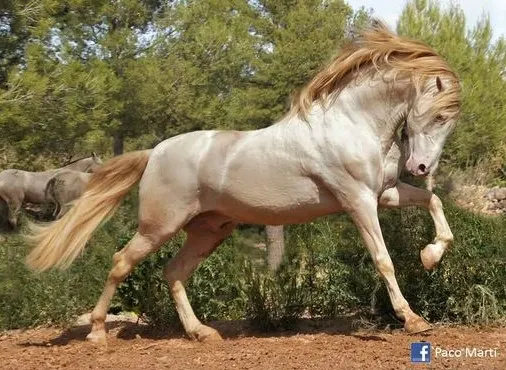
Pearl is an extremely rare and beautiful horse color that mainly shows up in horses with Spanish origins. It is caused by a certain dilution gene called the “barlink factor” that lightens the horse’s base color. It also gives many horses blue eyes.
The most common type of pearl is a chestnut pearl that features a uniform apricot color. However, the gene can affect any horse color, from black to palomino. Pearl Andalusians or Lusitanos demand high prices on the market due to their uniqueness and exquisite looks.
Pearl horses are easy to confuse with cremellos and perlinos, especially if they express the cream gene. However, pearl horses have a slightly darker and yellowish coat, while the other two are on the lighter side.
Leopard Spotting
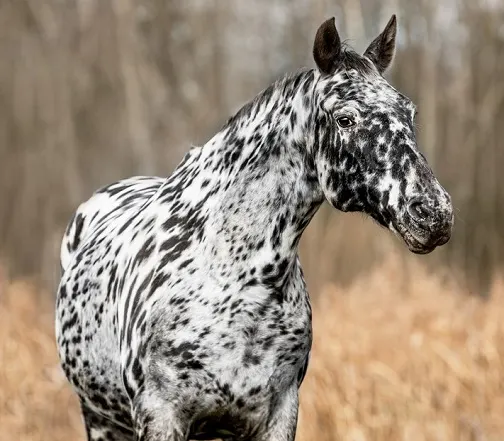
Leopard spotting causes colored sports to appear all over the horse’s body. The background color is either light or completely white, making good contrast with the dark spots. Leopard spotting is relatively common in the Knabstrupper, Appaloosa, and Noriker horse breeds but very rare in others.
Horses with leopard spotting also display the markings typical of all spotted horses. These are mottled skin around the eyes and muzzle, striped hooves, and a white sclera in the eyes.
A unique version of leopard spotting is peacock spots. Peacock sports have a white halo around them and often show up on roans, resulting in a truly unusual look. Peacock spotting can occur in some Appaloosa and Knabstrupper horses.
Sooty Buckskin

A sooty buckskin is a unique type of buckskin with black hairs spread across the horse’s topline, shoulders, and thighs. This rare horse color results from the sooty genetic modifier affecting a buckskin coat, giving the horse a “smoky” appearance.
Sooty horses become darker with age as the black hairs spread onto other parts of the body. The trait is considered to be heritable, although the exact genetic mechanisms haven’t been explored in great detail. This fabulous color can show up in most horse breeds.
Dominant White

The dominant white is one of the rarest horse colors on the planet. Horses with this color carry the “W” gene that causes them to be completely white.
Few people can correctly identify a dominant white horse. They are easy to confuse with light grays, cremellos, and perlinos. However, dominant white horses are different in a few key aspects.
Unlike other horse colors, dominant white horses have no pigment cells. Hence they are born with white hair, pink skin, and blue eyes. They are, however, not albinos, as albino animals have a normal distribution of pigment cells. As a matter of fact, albinism doesn’t exist in horses.
Dominant white horses also don’t carry the gene for the lethal white syndrome. Foals with this condition look identical to dominant white foals, but they die within 72 hours of birth. This is due to an undeveloped colon that prevents the foals from digesting milk.
Chocolate Flaxen

The chocolate flaxen is a gorgeous horse color where the horse has a dark chocolate coat with a flaxen mane and tail. This coat color is common in the Rocky Mountain and Morgan horse breeds, while Black Forest horses are exclusively this color.
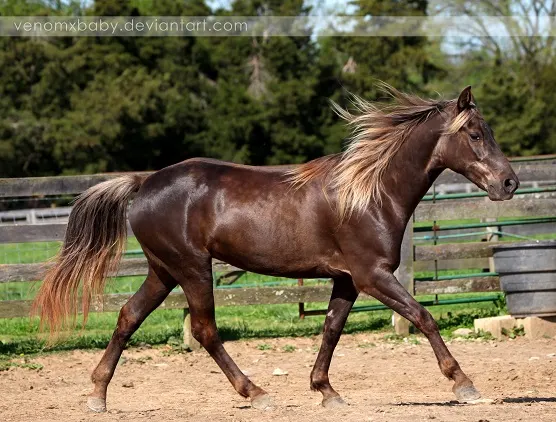
Chocolate flaxen horses have a chestnut base and a flaxen modifier that lightens the mane and tail. They may also retain streaks of dark hair in them. The chocolate flaxen is no doubt an enchanting horse color and a favorite of many horse lovers.


